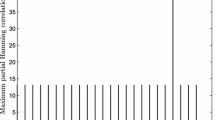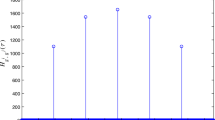Abstract
In a quasi-synchronous frequency-hopping multiple-access system, relative time delay between different users within a zone around the origin can be allowed. Therefore, frequency-hopping sequence (FHS) sets with low-hit-zone (LHZ) have attracted great interest of many related scholars. Moreover, on account of the limited synchronous time or hardware complexity, the periodic partial Hamming correlation (PPHC) plays a major role in determining the synchronization performance. In this paper, we first present three new generalized methods to construct LHZ-FHS sets via Cartesian product. Meanwhile, we pay our attention to the maximum periodic Hamming correlation (PHC) of the constructed LHZ-FHS sets in the first generalized method, and to the maximum PPHC of the constructed LHZ-FHS sets in the rest generalized methods. In addition, we also introduce five new classes of optimal LHZ-FHS sets based on these three generalized methods.
Similar content being viewed by others
References
Specification of the Bluetooth Systems-Core, The Bluetooth Special Interest Group (SIG), [online]. Available: http://www.bluetooth.com
Golomb, S.W., Gong, G.: Signal design for good correlation: For wireless communication, Cryptography and radar. Cambridge University Press, Cambridge (2005)
Fan, P.Z., Darnell, M.: Sequence Design for Communications Applications. Research Studies Press (RSP). Wiley, London (1996)
Apostol, T.M.: Introduction to analytic number theory. Springer-Verlag, NY, USA (1976)
Peng, D.Y., Fan, P.Z.: Lower bounds on the Hamming auto- and cross correlations of frequency-hopping sequences. IEEE Trans. Inf. Theory 50, 2149–2154 (2004)
Peng, D.Y., Fan, P.Z., Lee, M.H.: Lower bounds on the periodic Hamming correlations of frequency hopping sequences with low hit zone. Sci. China: Ser. F Inf. Sci. 49, 1–11 (2006)
Ye, W.X., Fan, P.Z.: Two classes of frequency hopping sequences with no-hit zone. In: Proceedings 7th International Symposium. on Communication Theory and Applications, pp. 304–306, Ambleside (2003)
Niu, X.H., Peng, D.Y., Liu, F., Liu, X.: Lower bounds on the maximum partial correlations of frequency hopping sequence set with low hit zone. IEICE Trans. Fund. E93-A, 2227–2231 (2010)
Ma, W.P., Sun, S.H.: New designs of frequency hopping sequences with low hit zone. Des. Codes Crypt. 60, 145–153 (2011)
Niu, X.H., Peng, D.Y., Zhou, Z.C.: New classes of optimal low hit zone frequency hopping sequences with new parameters by interleaving technique. IEICE Trans. Fund. Electron. Commun. Comput. Sci. E95-A, 1835–1842 (2012)
Chung, J.H., Yang, K.: New classes of optimal low-hit-zone frequency-hopping sequence sets by Cartesian product. IEEE Trans. Inf. Theory 59, 726–732 (2013)
Zhou, L.M.N., Peng, D.Y., Wang, C.Y., Han, H.Y.: Construction of Optimal or Near Optimal Frequency-Hopping Sequence Set with Low Hit Zone. IEICE Trans. Fund. Electron. Commun. Comput. Sci. E99-A, 983–986 (2016)
Liu, X., Peng, D.Y., Han, H.Y.: Low-hit-zone frequency hopping sequence sets with optimal partial Hamming correlation properties. Des. Codes Crypt. 73, 167–176 (2013)
Wang, C.Y., Peng, D.Y., Han, H.Y., Zhou, L.M.N.: New sets of low-hit-zone frequency-hopping sequence with optimal maximum periodic partial Hamming correlation. Sci. China Inf. Sci. 58, 1–15 (2015)
Cai, H., Yang, Y., Zhou, Z.C., Tang, X.H.: Strictly optimal frequency-hopping sequence sets with optimal family size. IEEE Trans. Inf. Theory 62, 1087–1093 (2016)
Zhou, Z., Tang, X., Niu, X., Udaya, P.: New classes of frequency-hopping sequences with optimal partial correlation. IEEE Trans. Inf. Theory 58, 453–458 (2012)
Solomon, G.: Optimall frequency hopping for multiple access. In: Proceedings in Symposium, pp. 33–35. Spread Spectrum Communication, San Diego (1977)
Kumar, P.V.: Frequency-hopping code designs having large linear span. IEEE Trans. Inf. Theory 34, 146–151 (1988)
Bao, J.J., Ji, L.J.: Frequency hopping sequences with optimal partial Hamming correlation. IEEE Trans. Accepted, doi:10.1109/TIT.2016.2551225
Acknowledgments
This work was supported by National Science Foundation of China (Grant No. 61271244), National High Technology Research and Development Program of China (863 Program) (Grant No. 2015AA01A705), and National Science Foundation of China (Grant No. 61571373). Limengnan Zhou and Hongbin Liang are corresponding authors.
Author information
Authors and Affiliations
Corresponding author
Rights and permissions
About this article
Cite this article
Zhou, L., Peng, D., Liang, H. et al. Generalized methods to construct low-hit-zone frequency-hopping sequence sets and optimal constructions. Cryptogr. Commun. 9, 707–728 (2017). https://doi.org/10.1007/s12095-017-0211-3
Received:
Accepted:
Published:
Issue Date:
DOI: https://doi.org/10.1007/s12095-017-0211-3
Keywords
- Frequency-hopping sequence set
- Low-hit-zone
- Hamming correlation
- Cartesian product
- Quasi-synchronous frequency-hopping multiple-access system




